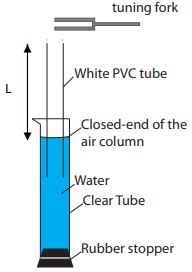Speed of Sound tube lab
Name __________________________________________ Period ________ Date ______________________

Speed of sound apparatus.
Speed of Sound Lab
Purpose: Calculate the speed of sound in the classroom using harmonics.
Materials:
- Speed of sound apparatus (as seen on right)
- Ruler
- Tuning forks
Procedure:
- Ensure that the water level is close to the top of the clear tube while the white tube is inside.
- Record the frequency of a tuning fork, then strike it and listen to the note that the fork makes. Then strike it again and hold it horizontally over the white tube.
- Move the tube up while listening closely to the sound. You should listen for the same note that you heard in step 2. When the sound increases in volume, adjust the height of the tube until you have the exact position where the sound is the loudest.
- Measure the length of the tube from the top to the water level, L. Record L in table.
- Repeat steps 2-4 with at least 3 different frequencies of tuning fork.
- With at least one tuning fork to find the second length where the volume increases. Record frequency and length of pipe in table.
Data:
| Frequency, f (Hz) | Length, L (m) | Harmonic, n | Speed of Sound (m/s) | *Wavelength, λ (m) | *Speed of Sound (m/s) |
Calculations: Calculate the speed of sound in the fourth column using the harmonics equation. (*You will calculate the last two columns in the Analysis Questions). Show the equation and your work here:
Analysis Questions:
- What was the average speed of sound that you calculated in the fourth column?
- Were your calculated speeds consistent? If not, why not?
- Which harmonic did you hear at the first spot the volume increased?
- Which harmonic did you hear at the second spot the volume increased?
- How many wavelengths are present in the first harmonic of a closed pipe?
- Using the information from #5, calculate the wavelengths of each harmonic and enter in your data table.
- Today you used the harmonic equation to calculate the speed of sound. What equation can you use to calculate the speed of sound using wavelength? Complete the last column in your data table using this equation.
- How does the fourth column compare to the last column?
- The accepted speed of sound is 332 m/s at 0º C, and increases 0.6 m/s for each Celsius degree above zero. Use a thermometer to find the temperature of the room in º C. What is the accepted value for the speed of sound in your classroom?
- What is the percent error for your results from #1?
